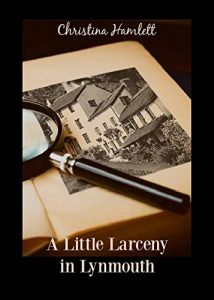WHEN ALL THE WORLD’S A STAGE (BUT SOMEONE HAS TO WRITE FOR IT)
By Christina Hamlett
 As of this writing, I’ve been involved with theatre since 1971 as an actress, director, playwright, instructor and script consultant. Is it any wonder my heart is gladdened whenever someone says, “I have an idea for a play. Can you show me how to start?”
As of this writing, I’ve been involved with theatre since 1971 as an actress, director, playwright, instructor and script consultant. Is it any wonder my heart is gladdened whenever someone says, “I have an idea for a play. Can you show me how to start?”
While technology has brought sophisticated changes insofar as how plays are produced, the why behind theatre’s importance has changed very little since the time of the Greeks; specifically, it exists to provide audiences a shared experience with the vitality, intimacy and immediacy of a live performance. It’s also the quintessential “do-over” in that (1) it’s never exactly the same performance twice and (2) the same script can be performed by different actors at different theatres for longer than a playwright’s own lifetime.
Though “script” is often used interchangeably in referring to projects for stage and screen, make no mistake that a play is not the same as a movie and should not be approached as such. A play is its own wondrous creature and, happily enough, can find its way into sustainable paying markets and publication much faster than waiting for Hollywood to come knocking on your door.
PREREQUISITES
You don’t need a degree in Theatre Arts to become playwright. (My own degree is in Communications with an emphasis on Audience Analysis and Message Design.) While a TA curriculum can be helpful, you can learn just as much from books on playwriting.
You need an absolute passion for the performing arts. This means attending as many plays as you can, reading scripts cover-to-cover, streaming world-class theatre at home (https://www.nationaltheatre.org.uk/ntathome) and participating in online forums with fellow wordsmiths. I also recommend taking acting classes or volunteering as part of the tech crew at local theatres.
Friends to read your scenes out loud. This is a must. If you want to ensure your dialogue sounds natural, you need to hear it delivered from the mouths of real people and not just the singular voice in your head.
LENGTH AND FORMAT
Plays encompass a variety of lengths—monologues, skits, one-acts, two-acts, and three-acts. The general rule is that one page of text equals one minute of playing time. Text isn’t just dialogue, though; it also includes scene settings, character descriptions and action lines, all of which should be kept to a minimum so as not to have it read like a novel.
There are also formatting rules which comprise what’s called “industry standard” and these are essential if you plan to enter your plays in competition. (To eliminate the mystery of which elements go where, my own go-to software program for playwriting and screenwriting is Final Draft. https://www.finaldraft.com/.)
If you’re just starting out, try penning shorter works first. This will not only hone your skills at making every word count but a collection of short pieces which embrace a common theme can be stitched into a full evening’s entertainment. As an example, I’ve written a number of monologue collections for my British publisher, Silver Burchington, including my most recent series about famous women in history (https://www.silverbirchingtonplays.com/product-page/remembered-an-evening-of-monologues-by-christina-hamlett). This enables prospective producers to license individual scripts or pick and choose how many they’d like to assemble for a single show.
APPROACHABILITY
The plot you’ve composed may be the greatest play ever written but if it involves holograms, pyrotechnics, staircases, balconies, hydraulic lifts, turntables, multiple sets requiring extensive wing and fly space (those areas offstage and above the stage), and a cast of hundreds with copious costume changes, I’m afraid you’re not going to get a “yes” from a 75-seat community theatre in small-town Iowa. The more complicated—and expensive—your production is, the more reasons you’re handing a producer a chance to decline.
The reason many of my own plays embrace an economical approach stems from the years I spent running a touring theatre company. The rule we followed was, “If it doesn’t fit in the car, it’s not going.” Too often I see new playwrights add a piano or a moosehead into their set design even though no one ever plays the piano or comments on what Bullwinkle is doing on the wall. Before you incorporate a specific set piece, furniture or props into the tableau, ask yourself if the play could actually function without them.
Keep in mind that one of the best things about theatre audiences is that they can process levels of abstraction at a higher level than movie audiences. If you tell them—either in the program or via a narrator—that an empty stage is the middle of the Black Forest or a street corner in London in the 1920s, their imaginations will fill in the blanks without you having to invest in trees or buildings. Obviously if you find a producer who can afford all the glamorous extras, that’s awesome. What you don’t want to do, though, is alienate small companies who truly love your story but don’t have deep pockets. Prior to pitching theatres, do your homework and see what types of shows they’ve done in the past and whether yours would comfortably be in their wheelhouse.
THE PUBLISHING ROUTE
Many people read plays just for their own enjoyment. Whether or not they ever see full production, there’s no shortage of publishing avenues to make your script available in print or online. Stageplays.com (https://www.stageplays.com/), for instance, is a worldwide script-finding warehouse where readers can filter selections by cast size, genre and even country. Among these are actors, directors, teachers and producers, thus increasing the chances of your next theatrical opportunity discovering you!
Want to learn more? Christina teaches an online class in playwriting which covers the basics of plot, character development, dialogue, pacing, set design, and where to find potential markets. Students work at their own pace and receive one-on-one feedback for their homework assignments. In addition, you might want to check out “The Play’s The Thing (And How To Write It,” “101 Plots for Stage, Page and Cinema,” and “How To Kick Your Writer’s Block To The Curb” (all of which are available on Amazon). If there’s a particular question you’d like answered, you can contact her at authorhamlett@cs.com or via her website at www.authorhamlett.com.
—
Christina Hamlett
The picturesque harbor village of Lynmouth on the Devon coast was supposed to be a respite after being made redundant from her job at a prestigious import/export firm in London. But when her landlady is poisoned by chocolate a scant three days after she moves in, Rochelle Reid and her new neighbors discover they have become overnight murder suspects.
Red herrings abound, romance teases, a heroine learns her past is about to collide with the present, and a daylight break-in at the house hints that—even with a victim neatly out of the way—the murderer is not yet in the clear if a damning piece of evidence hidden within its walls isn’t recovered.
BUY HERE
Category: How To and Tips

























Christina,
This piece about playwriting is superb!
Potential playwriters will be beating a path to your website.
It is thrilling to see your exceptional talent in action!
Charlie